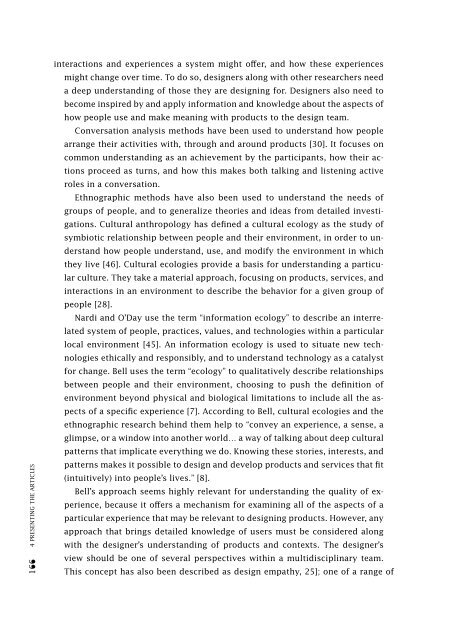Co-experience: Understanding user experiences in social interaction
Co-experience: Understanding user experiences in social interaction
Co-experience: Understanding user experiences in social interaction
Create successful ePaper yourself
Turn your PDF publications into a flip-book with our unique Google optimized e-Paper software.
166 4 PRESENTING THE ARTICLES<br />
<strong>in</strong>teractions and <strong>experience</strong>s a system might offer, and how these <strong>experience</strong>s<br />
might change over time. To do so, designers along with other researchers need<br />
a deep understand<strong>in</strong>g of those they are design<strong>in</strong>g for. Designers also need to<br />
become <strong>in</strong>spired by and apply <strong>in</strong>formation and knowledge about the aspects of<br />
how people use and make mean<strong>in</strong>g with products to the design team.<br />
<strong>Co</strong>nversation analysis methods have been used to understand how people<br />
arrange their activities with, through and around products [30]. It focuses on<br />
common understand<strong>in</strong>g as an achievement by the participants, how their actions<br />
proceed as turns, and how this makes both talk<strong>in</strong>g and listen<strong>in</strong>g active<br />
roles <strong>in</strong> a conversation.<br />
Ethnographic methods have also been used to understand the needs of<br />
groups of people, and to generalize theories and ideas from detailed <strong>in</strong>vestigations.<br />
Cultural anthropology has def<strong>in</strong>ed a cultural ecology as the study of<br />
symbiotic relationship between people and their environment, <strong>in</strong> order to understand<br />
how people understand, use, and modify the environment <strong>in</strong> which<br />
they live [46]. Cultural ecologies provide a basis for understand<strong>in</strong>g a particular<br />
culture. They take a material approach, focus<strong>in</strong>g on products, services, and<br />
<strong>in</strong>teractions <strong>in</strong> an environment to describe the behavior for a given group of<br />
people [28].<br />
Nardi and O’Day use the term “<strong>in</strong>formation ecology” to describe an <strong>in</strong>terrelated<br />
system of people, practices, values, and technologies with<strong>in</strong> a particular<br />
local environment [45]. An <strong>in</strong>formation ecology is used to situate new technologies<br />
ethically and responsibly, and to understand technology as a catalyst<br />
for change. Bell uses the term “ecology” to qualitatively describe relationships<br />
between people and their environment, choos<strong>in</strong>g to push the def<strong>in</strong>ition of<br />
environment beyond physical and biological limitations to <strong>in</strong>clude all the aspects<br />
of a specific <strong>experience</strong> [7]. Accord<strong>in</strong>g to Bell, cultural ecologies and the<br />
ethnographic research beh<strong>in</strong>d them help to “convey an <strong>experience</strong>, a sense, a<br />
glimpse, or a w<strong>in</strong>dow <strong>in</strong>to another world… a way of talk<strong>in</strong>g about deep cultural<br />
patterns that implicate everyth<strong>in</strong>g we do. Know<strong>in</strong>g these stories, <strong>in</strong>terests, and<br />
patterns makes it possible to design and develop products and services that fit<br />
(<strong>in</strong>tuitively) <strong>in</strong>to people’s lives.” [8].<br />
Bell’s approach seems highly relevant for understand<strong>in</strong>g the quality of <strong>experience</strong>,<br />
because it offers a mechanism for exam<strong>in</strong><strong>in</strong>g all of the aspects of a<br />
particular <strong>experience</strong> that may be relevant to design<strong>in</strong>g products. However, any<br />
approach that br<strong>in</strong>gs detailed knowledge of <strong>user</strong>s must be considered along<br />
with the designer’s understand<strong>in</strong>g of products and contexts. The designer’s<br />
view should be one of several perspectives with<strong>in</strong> a multidiscipl<strong>in</strong>ary team.<br />
This concept has also been described as design empathy, 25]; one of a range of

















